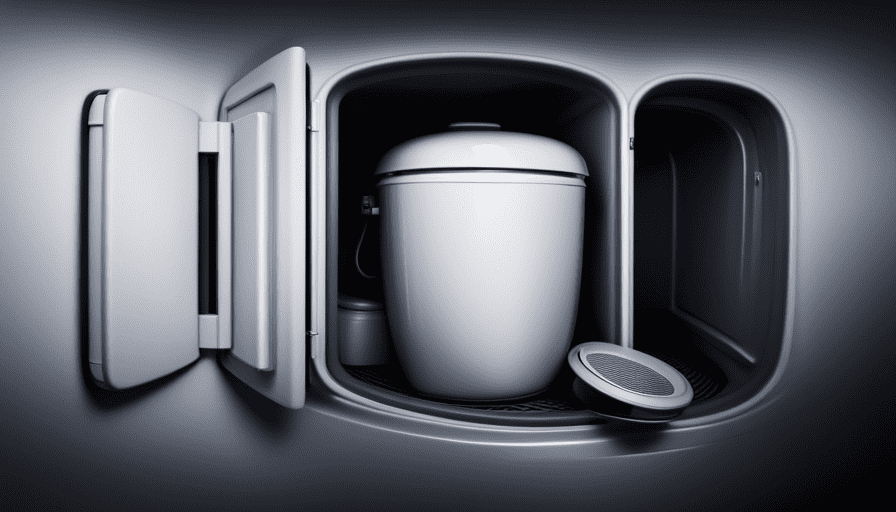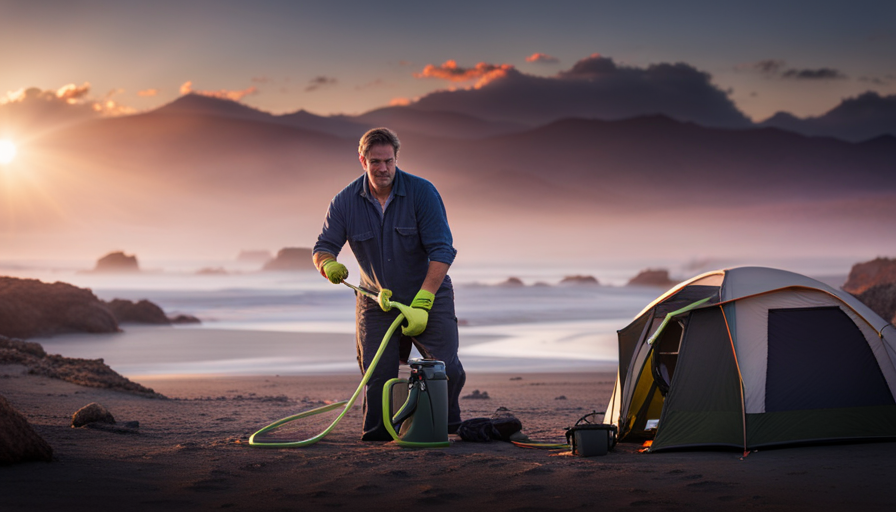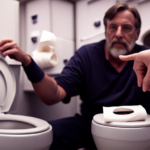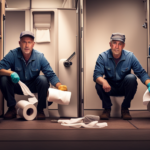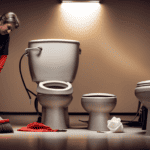Are you ready to embark on your upcoming camping adventure?
Picture this: you’re deep in the wilderness, surrounded by nature’s beauty, and you suddenly feel the urge to use the restroom. But wait! There’s no need to panic because camper toilets are here to save the day!
These marvels of engineering may seem simple on the surface, but they are actually quite intricate. In this article, I will take you on a journey through the inner workings of camper toilets and unveil their secrets. From flushing mechanisms to waste management systems, we will explore it all.
I’ll also share tips on how to choose the right camper toilet for your needs and provide insights into maintenance and troubleshooting. So get ready to dive into the world of camper toilets and discover how these incredible devices make our outdoor adventures more comfortable and convenient.
Key Takeaways
- Camper toilets can be gravity-flush or foot pedal flush mechanisms and may have antimicrobial surfaces and odor control systems.
- There are two main types of camper toilets: composting toilets and chemical toilets. Composting toilets separate urine and solid waste, while chemical toilets use chemicals to control odors and break down waste.
- Camper toilets typically have a separate water tank for flushing and may have a bidet feature for cleaning. Water conservation is important in camper toilets.
- Proper waste disposal is crucial in camper toilets, whether it is through black water tanks, composting features, biodegradable bags, or designated dump stations or septic systems. Using biodegradable toilet paper and being mindful of the amount used can also help reduce waste and prevent clogs.
The Basics of Camper Toilets
So, you’re wondering how camper toilets actually work, huh? Well, let’s dive in and uncover the fascinating mechanics behind these essential conveniences on the road.
When it comes to camper toilets, there are various portable options available, but one innovative solution gaining popularity is composting toilets.
Composting toilets are self-contained units that use the natural process of decomposition to turn waste into organic compost. They work by separating solid waste from liquid waste, eliminating the need for water or chemicals. The solid waste is mixed with organic materials like sawdust or coconut coir to promote decomposition and minimize odor. Over time, the waste breaks down into nutrient-rich compost that can be safely disposed of or used as fertilizer.
Composting toilets offer several advantages for campers. They are environmentally friendly, as they conserve water and reduce pollution. They are also convenient, as they don’t require a connection to a water source or a sewage system. Moreover, they are odorless when properly maintained, making them a pleasant option for extended trips.
Now that you understand the basics of camper toilets, let’s move on to the next section and explore their flushing mechanisms.
Flushing Mechanisms
To understand the inner workings of camper toilets, imagine a gentle push on a lever transforming the chaos within into a swift and efficient cleansing cascade. The flushing mechanism of camper toilets is designed to ensure proper toilet cleaning while maintaining the portability of the unit.
Most camper toilets utilize a gravity-flush system. When the lever is pressed, water from the onboard freshwater tank is released into the toilet bowl. This surge of water creates a force that pushes waste down into the holding tank. The water flow also helps to rinse the bowl, leaving it clean and ready for the next use.
Some camper toilets incorporate a foot pedal flush instead of a lever. This pedal operates a valve that releases water into the bowl, achieving the same flushing action as the lever system. This design allows for hands-free operation, which can be beneficial in situations where hygiene is a concern.
In addition to the flushing mechanism, camper toilets often have features like antimicrobial surfaces and odor control systems to maintain cleanliness and freshness.
Transitioning into the subsequent section about waste management systems, it is important to consider how the waste is stored and disposed of in camper toilets.
Waste Management Systems
The waste management system in camper toilets involves storing and disposing of waste in a sanitary and efficient manner. There are two main types of camper toilets: composting toilets and chemical toilets.
Composting toilets use the natural process of decomposition to break down waste into compost. They require little to no water and are eco-friendly. These toilets have separate chambers for urine and solid waste. The urine is diverted to a separate container, while the solid waste is mixed with a composting material, such as sawdust or peat moss, to aid in decomposition. Over time, the waste breaks down into compost that can be safely disposed of or used as fertilizer.
Chemical toilets, on the other hand, use chemicals to control odors and break down waste. These toilets have a holding tank that contains a mixture of water and chemicals. When the toilet is flushed, the waste is mixed with the chemical solution, which helps to break it down and control odors. The waste is stored in the holding tank until it can be properly disposed of at a designated waste disposal site.
Moving on to water supply and usage, camper toilets typically have a separate water tank for flushing. This tank is filled with fresh water and is used to flush the toilet bowl. Some camper toilets also have a bidet feature that uses water for cleaning.
Water Supply and Usage
You might think that water is a limitless resource when using camper toilets, but think again. Water conservation is a crucial aspect of camper toilets, as the water supply is often limited. To ensure sustainable water usage, portable options are available that minimize water consumption. These options include composting toilets and portable chemical toilets.
In composting toilets, water usage is minimal or even eliminated. These toilets separate solid waste from liquid waste, allowing the solid waste to decompose naturally over time. Liquid waste is typically directed to a separate container, which can be emptied and disposed of appropriately. This method not only saves water but also promotes eco-friendly waste management.
On the other hand, portable chemical toilets use a small amount of water mixed with chemicals to break down the waste and control odors. These toilets have a built-in holding tank that can be emptied at designated dumping stations. While water usage is still involved, it is significantly less compared to traditional flush toilets.
By utilizing these portable options and practicing water conservation, camper toilet users can minimize their environmental impact while still maintaining hygienic conditions. Speaking of maintaining cleanliness, let’s now explore the next important aspect of camper toilets: odor control.
Odor Control
With effective odor control, camper toilet users can enjoy a fresh and pleasant environment during their outdoor adventures. To achieve this, various sanitation methods and chemical additives are utilized. Here are four key elements that contribute to effective odor control in camper toilets:
-
Ventilation: Proper ventilation is essential to remove unpleasant odors from the toilet compartment. Ventilation systems, such as exhaust fans or vents, help to circulate fresh air and eliminate any lingering smells.
-
Chemical Additives: Many camper toilets use chemical additives in the waste holding tank to neutralize odors. These additives, which often come in liquid or tablet form, break down waste and suppress the growth of bacteria that can cause foul odors.
-
Waste Disposal: Regular and proper disposal of waste is crucial to prevent odor buildup. Emptying the waste holding tank in designated dump stations or sanitary facilities ensures that waste is removed from the camper and eliminates potential odor sources.
-
Cleaning and Maintenance: Regular cleaning and maintenance of the toilet system are essential for odor control. This includes emptying and rinsing the waste holding tank, cleaning the toilet bowl, and replacing chemical additives as needed.
With effective odor control measures in place, camper toilets can provide a hygienic and pleasant experience for outdoor enthusiasts. Transitioning to the subsequent section about ‘space and design considerations,’ it’s important to consider these factors to optimize the camper toilet experience.
Space and Design Considerations
Optimizing the camper toilet experience involves carefully considering the spatial layout and design elements. Design limitations and the need for compact solutions make it crucial to maximize the available space while maintaining functionality and comfort.
When it comes to camper toilets, space is a precious commodity. Manufacturers understand this and have come up with innovative designs to address these limitations. One common approach is to use a space-saving, compact toilet bowl that takes up less room without sacrificing comfort. These toilets often feature a smaller footprint and a lower profile, allowing them to fit into tight spaces.
Additionally, camper toilets often incorporate clever design elements to make the most of the available space. For example, some models have built-in storage compartments or shelves for toiletries and other essentials. Others may feature foldable seats or collapsible components that can be easily stowed away when not in use. These design solutions help to maximize the functionality of the toilet while minimizing the impact on the overall space.
Considering the design limitations and the importance of compact solutions, camper toilets are carefully crafted to provide an efficient and comfortable experience in a limited space. By optimizing the layout and incorporating space-saving features, manufacturers ensure that campers can enjoy a functional toilet without compromising on comfort or convenience.
Transitioning into the next section about maintenance and troubleshooting, it’s important to understand how to properly care for and address any potential issues that may arise with your camper toilet.
Maintenance and Troubleshooting
To properly maintain and troubleshoot your camper toilet, it’s important to understand the necessary care and potential issues that may arise.
One common problem with camper toilets is toilet leaks. These leaks can occur in various parts of the toilet, such as the seals or the water supply line. It’s important to regularly inspect these areas for any signs of leakage and address them promptly to prevent further damage.
Another issue that campers may encounter is clogged pipes. This can happen when waste and toilet paper accumulate and block the flow of water through the pipes. To prevent this, it’s essential to use RV-friendly toilet paper that dissolves easily.
When troubleshooting a clogged pipe, you can try using a plunger or a specialized RV toilet auger to remove the obstruction. It’s also a good idea to regularly clean the toilet bowl and tanks to prevent buildup and maintain proper functioning.
Understanding these common maintenance and troubleshooting techniques will help ensure that your camper toilet functions optimally during your trips.
Now, let’s consider the environmental impact of camper toilets without forgetting about our responsibilities as outdoor enthusiasts.
Environmental Impact
Minimize your ecological footprint by considering the environmental impact of your camper toilet and how it affects the natural beauty of the outdoors.
Camper toilets, like any other type of toilet, have a carbon footprint associated with their use. The carbon footprint is the amount of greenhouse gases, mainly carbon dioxide, released into the atmosphere as a result of their operation. This is primarily due to the energy required to treat and transport the water used for flushing, as well as the emissions produced during waste disposal.
When it comes to waste disposal, camper toilets have several options. Some models use a black water tank, which holds the waste until it can be emptied at a designated dump station. Others may have a composting feature, where the waste is broken down naturally over time. This method reduces the need for chemical treatments and eliminates the need for a black water tank. Additionally, there are portable toilets that use biodegradable bags for waste collection, making disposal more convenient and environmentally friendly.
Considering the environmental impact of your camper toilet is important for preserving the natural beauty of the outdoors. By understanding the carbon footprint and waste disposal options, you can make informed decisions to minimize your impact.
Now, let’s move on to some tips for using camper toilets.
Tips for Using Camper Toilets
One easy way to enhance your experience with camper toilets is by following these helpful tips.
When it comes to toilet paper alternatives, consider using biodegradable options such as recycled paper or bamboo. These alternatives are more environmentally friendly and can help reduce waste. Additionally, be mindful of the amount of toilet paper you use to avoid clogs in the system.
Proper waste disposal is crucial when using camper toilets. Always use designated dump stations or septic systems to dispose of waste. Never dump waste in natural bodies of water or on the ground, as this can contaminate the environment. It’s also important to properly empty and clean the waste holding tank of your camper toilet regularly to prevent odors and maintain hygiene.
As you move forward in choosing the right camper toilet, it’s essential to consider factors such as size, weight, and capacity. Additionally, think about the type of toilet that best suits your needs, whether it’s a cassette toilet, composting toilet, or portable chemical toilet. Each type has its own advantages and disadvantages, so it’s important to research and choose accordingly.
By following these tips and considering the right camper toilet for your needs, you can ensure a more enjoyable and hassle-free experience on your camping trips.
Choosing the Right Camper Toilet
When it comes to enhancing your camping experience, finding the perfect camper toilet that suits your needs is essential. There are various portable options available in the market, but one popular choice among campers is composting toilets. These toilets are an eco-friendly alternative that uses the natural process of decomposition to turn waste into compost.
Composting toilets are designed to separate liquids and solids, reducing odor and promoting decomposition. They typically consist of two chambers, one for urine and another for solid waste. The urine is diverted to a separate container, while the solid waste is mixed with organic materials such as sawdust or coconut coir to aid in the composting process.
To help you choose the right camper toilet, here is a table outlining some key features and benefits of composting toilets:
| Feature | Benefit |
|---|---|
| Eco-friendly | Reduces water usage and produces compost |
| Odor control | Separation of waste minimizes unpleasant smells |
| Low maintenance | Easy to clean and maintain |
| Versatility | Can be used in various camping environments |
| Cost-effective | Saves money on water and sewage hookup fees |
By considering these factors and understanding how composting toilets work, you can make an informed decision and find the ideal camper toilet that meets your needs and enhances your camping experience.
Frequently Asked Questions
Can I use regular toilet paper in a camper toilet?
Sure, you can use regular toilet paper in a camper toilet, but there are alternatives you might consider.
One option is using biodegradable toilet paper, which breaks down faster and is better for the environment.
Another alternative is using damp wipes specifically designed for RV toilets.
Regular toilet paper can sometimes clog the plumbing system because it doesn’t dissolve as easily.
So, while it’s possible to use regular toilet paper, it’s important to weigh the pros and cons.
How often should I empty the waste tank of a camper toilet?
I empty the waste tank of my camper toilet every 2-3 days to maintain proper hygiene and prevent any unpleasant odors. The frequency of emptying depends on the size of the tank and the number of people using the toilet.
It is important to follow the manufacturer’s guidelines for waste disposal, which may involve using designated dump stations or portable waste tanks. Proper waste disposal ensures a clean and functional camper toilet.
Are camper toilets easy to install in a recreational vehicle?
Installing a camper toilet in a recreational vehicle is a relatively straightforward process. The installation typically involves connecting the toilet to the RV’s plumbing system and securing it in place.
However, there are a few common problems that may arise during the installation process. These include leaks, improper connections, and difficulties in finding suitable locations for the toilet.
It’s important to carefully follow the manufacturer’s instructions and seek professional help if needed to ensure a successful installation.
Can I use bleach to clean a camper toilet?
Yes, you can use bleach to clean a camper toilet, but there are also bleach alternatives that may be better suited for this task.
When cleaning a camper toilet, it’s important to use products specifically designed for this purpose. Some of the best cleaning products for camper toilets include toilet bowl cleaners and sanitizers. These products effectively remove stains and kill bacteria, ensuring a clean and hygienic toilet.
What is the average lifespan of a camper toilet?
The average lifespan of a camper toilet depends on various factors such as usage, maintenance, and the quality of the toilet itself. With proper care and regular maintenance, a camper toilet can last anywhere from 5 to 10 years.
To extend its lifespan, it’s recommended to clean it regularly using mild cleaners suitable for camper toilets, avoid using harsh chemicals, and ensure proper ventilation to prevent moisture buildup.
How Does the Lift System in a Pop Up Camper Work?
The pop up camper lift system is an essential mechanism that allows for easy setup and teardown of these portable camping vehicles. Using a series of cables and pulleys, the system raises the roof and expands the living space. By cranking a handle, the pop up camper lift system effortlessly elevates the roof, transforming it into a cozy and comfortable camping haven.
Conclusion
In conclusion, camper toilets are essential for maintaining hygiene and comfort while on the road. Understanding how they work and properly maintaining them is crucial for a pleasant camping experience.
Did you know that a typical camper toilet uses only about 1-2 liters of water per flush? This not only conserves water but also reduces the environmental impact.
So, next time you’re out camping, remember to choose the right camper toilet and follow the tips provided to ensure a hassle-free and eco-friendly trip.

